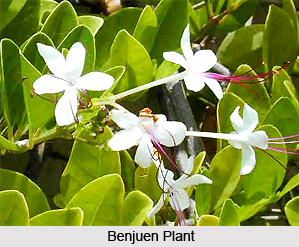 Benjuen is a highly-branched, erect or struggling evergreen shrub found in India. It grows about 2.5 meters in height. Its botanical name is Clerodendrum inerme (L.) Gaertn. Some of the other names by which Benjuen is called in India in different languages are Banjai, Batraj, Bonjoi and Bun-jumat in Bengali, Kundali, Naitakkilai, Vishamadhari and Nayitakkali in Kannada, Kundali in Sanskrit, Eruppichha, Pishinika, Takkolkamu, Utichettu and Pisung in Telugu, Cholora in Oriya, Pinarichanganguppu, Pinasangam-koppi, Sangam and Pinchil in Tamil, Nirnochi and Nirnotijil in Malayalam, Batraj, Lanjai, Binjoam and San-gan-kuppi in Hindi and Dariajai in Gujarati. Benjuen is mainly found in the coastal regions of India.
Benjuen is a highly-branched, erect or struggling evergreen shrub found in India. It grows about 2.5 meters in height. Its botanical name is Clerodendrum inerme (L.) Gaertn. Some of the other names by which Benjuen is called in India in different languages are Banjai, Batraj, Bonjoi and Bun-jumat in Bengali, Kundali, Naitakkilai, Vishamadhari and Nayitakkali in Kannada, Kundali in Sanskrit, Eruppichha, Pishinika, Takkolkamu, Utichettu and Pisung in Telugu, Cholora in Oriya, Pinarichanganguppu, Pinasangam-koppi, Sangam and Pinchil in Tamil, Nirnochi and Nirnotijil in Malayalam, Batraj, Lanjai, Binjoam and San-gan-kuppi in Hindi and Dariajai in Gujarati. Benjuen is mainly found in the coastal regions of India.
Benjuen is a highly-branched, straggling or erect, evergreen shrub which grows up to 2.5 meters in height. The colour of its bark is dark brown to light grey, fissured and soft. The branches and branchlets of this shrub are quadrangular. Leaves of Benjuen are opposite, aromatic, succulent, generally 2 to 5 centimeters long and 1.3 to 2.5 centimeters wide, elliptic to narrowly lanceolate, apex obtuse, base acute and the petioles are 0.6 to 1 centimeter long. Flowers borne 3 to 9 together in axillary pedunculate 3 to 9 flowered cymes; peduncles are slender, 1.3 to 4.5 centimeters long; bracts minute, linear or subulate; calyx 5 millimeter long, enlarged in fruit, teeth triangular, c. 1.2 millimeter long, acute; corolla white, tube slender c. 2.5 centimeter long, glabrous outside, very hairy inside, lobes sub equal, 6 to 10 millimeters long, oblong, obtuse, with slightly crenulated margins; filaments very long, hairy at the base. Fruit is pyriform, 1.3 to 1.6 centimeters long, spongy, brown, in a veined persistent calyx, separating into four woody pyrenes. The flowers and fruits of Benjuen are borne between the months of March and June.
Benjuen is a widely distributed, polymorphic species found along seacoasts, in salt marshes, mangrove and freshwater swamp forests and along muddy tidal riverbanks in India. It is found in the coastal regions and on riverbanks in open, degraded sites and in hedges; often planted in gardens in India.
In Ayurveda, this medicinal plant of India is used as a substitute for quinine and chirata (Swertia chiravita: Gentianaceae), given in the form of a tincture or decoction to treat intermittent and remittent fevers. The leaves of this medicinal plant are mucilaginous, fragrant and bitter; both the dried leaves and the juice of the roots and fresh leaves are regarded as an alterative and are used to treat scrofula and venereal diseases. The leaf juice is a popular febrifuge in the state of Maharashtra. The root, boiled in oil, is used as a liniment for treating rheumatism; the juice of the root is considered alterative. In Siddha, the leaves and roots are used to treat eczema, glandular swellings, leucor-rhoea and scabies.



















